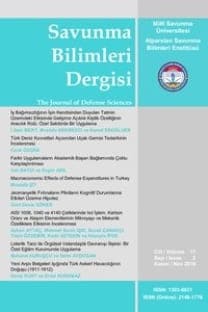Veri Kaçağı Tespitinde Yeni Bir Yaklaşım
A New Approach on Data Leakage Detection
___
- Agrawal, R., Haas, P. J., ve Kiernan, J. (2003). Watermarking relational data: framework, algorithms and analysis. VLDB Journal, 12, 157- 169.
- Anjali, N. B., Geetanjali, P. R., Shivlila, P., Swati, R. S., ve Kadu, N. B. (2013). Data leakage detection. International Journal of Computer Science and Mobile Computing, 2(5), 283-288.
- Ansari, Z. S., Jagtap, A. M., ve Raut, S. S. (2013). Data leakage detection and e-mail filtering. International Journal of Innovative Research in Computer and Communication Engineering, 1(3), 565-567.
- Bansode, S. A., Jadhav, U. M., ve Patil, N. K. (2013). Data leakage detection. Journal of Engineering, Computers & Applied Sciences, 2(4), 30-34.
- Barge, P., Dhawale, P., ve Kolashetti, N. (2013). A novel data leakage detection. International Journal of Modern Engineering Research, 3(1), 538-540.
- Chaware, N., Bapat, P., Kad, R., Jadhav, A., ve Sangve, S. M. (2012). Data leakage detection. International Journal of Scientific Engineering and Technology, 1(2), 272-273.
- Jadhav, R. (2013). Data leakage detection. International Journal of Computer Science & Communication Networks, 3(1), 37-45.
- Jagap, N. P., ve Patil, S. S. (2012). Implementation of guilt model with data watcher for data leakage detection system. International Journal of Emerging Technology and Advanced Engineering, 2(3), 318-322.
- Jaseena, K., ve John, A. (2011). Text watermarking using combined image and text for authentication and protection. International Journal of Computer Applications, 20(4), 8-13.
- Kale, S. A., ve Kulkarni, S. V. (2012a). Data leakage detection. International Journal of Advanced Research in Computer and Communication Engineering, 1(9), 668-678.
- Kale, S. A., ve Kulkarni, S. V. (2012b). Data leakage detection: A survey. Journal of Computer Engineering, 1(6), 32-35.
- Liu, A. Fragile Database Watermarking. 29 Mart 2015 tarihinde http://web.ics.purdue.edu/~liu1010/research.html alınmıştır. adresinden
- Papadimitriou, P., ve Garcia-Molina, H. (2011). Data leakage detection. IEEE Transactions on Knowledge and Data Engineering, 23(1), 51- 63.
- Patil, S., ve Bhole, H. (2013). Data leakage detection system for diabetes patients DB. International Journal of Computer Trends and Technology, 4(5), 893-897.
- Patil, S., ve Prasanthi, M. L. (2013). Modern approaches for detecting data leakage problems. International Journal of Engineering and Computer Science, 2(2), 395-399.
- Pol, R., Thakur, V., ve Bhise, R. (2012). Data leakage detection. International Journal of Engineering Research and Applications, 2(3), 404-410.
- Pournaghshband, V. (2008). A new watermarking approach for relational data. ACM-SE, 127-131.
- Shapira, Y., Shapira, B., ve Shabtai, A. (2013). Content-based data leakage detection using extendend fingerprinting. 27 Mart 2015 tarihinde http://arxiv.org/abs/1302.2028 adresinden alınmıştır.
- Shu, X., ve Yao, D. (2012). Data leak detection as a service: challenges and solutions. https://core.ac.uk/display/10676283 adresinden alınmıştır. Mart 2015 tarihinde
- Singh, M., Tripathi, P., ve Singh, R. (2013). Detection of data leakage. International Journal of Computer & Communication Technology, 4(3), 22-24.
- Singh, S. (2013). Data leakage detection using rsa algorithm. International Journal of Application or Innovation in Engineering & Management, 2(234-238).
- Vaidya, A., Lahange, P., More, K., Kachroo, S., ve Pandey, N. (2012). Data leakage detection. International Journal of Advances in Engineering & Technology, 3(1), 315-321.
- Zhou, X., ve Tang, X. (2011). Research and implementation of rsa algorithm for encryption and decryption. The 6th International Forum on Strategic Technology.
- ISSN: 1303-6831
- Yayın Aralığı: 2
- Başlangıç: 2002
- Yayıncı: Milli Savunma Üniversitesi Alparslan Savunma Bilimleri ve Millî Güvenlik Enstitüsü
Enerji Güvenliğine Küresel Ölçekte Bir Bakış
A New Cooling Technique for Military Systems; Transpiration Cooling
NATO Balistik Füze Savunma Sistemi İçinde Türkiye'nin Yeri
AHP ve SMAA-2 Yöntemleri ile Mühendislik Alanında Bilimsel Araştırma Konularının Seçimi
Aslı ÇALIŞ, Cevriye GENCER, İbrahim KESKİN
Yenilikçi İklimin ve Sosyal Sermayenin Bilgi Paylaşımı ve Yenilikçi Davranışa Etkisi
Memduh BEĞENİRBAŞ, Ercan TURGUT
A Survey on Interactive Approaches for Multi-Decision Making Problems
A Comparative Study of the Impact of Defense Expenditures on Economic Growth in Indonesia and Turkey
Anton Abdul FATAH, Salih SALIHOGLU
Veri Kaçağı Tespitinde Yeni Bir Yaklaşım
Re-construction of a Target Motion Shape with Self-Mixing Laser Diode System
